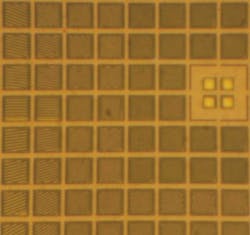Cornell researchers demonstrate optics-free pixel array for far-field imaging
Each ASP reports one component of a spatial 2-D Fourier transform of the local light field. Concentric rings of ASPs with increasingly high sinusoidal periodicity yield a complete Fourier description of the light intensity from the far field. The slowly varying orientation of ASPs is visible on the enlarged figure of the PFCA. The effective resolution of the prototype is approximately 400 pixels.
The camera was developed in the lab of Alyosha Molnar, assistant professor of electrical and computer engineering, and developed by a group led by Patrick Gill, a postdoctoral associate. Their working prototype is detailed in the journal Optics Letters (July 6, 2011). “It’s not going to be a camera with which people take family portraits, but there are a lot of applications out there that require just a little bit of dim vision,” Gill said.
Gill, whose other research relate to how the brain’s neurons fire under certain stimuli, began this work as a side project related to developing lens-less implantable systems for imaging brain activity. This type of imaging system could be useful as part of an implantable probe for imaging neurons that have been modified to glow when they are active.
The researchers believe the PFCA could be a suitable choice for a large range of cost- and size-sensitive applications that cannot be served with focusing optical systems; for example, low-cost electronic system that detect the angle of the sun or a micro-robot that requires a simple visual system to navigate. Funding for this work was provided by the Defense Advanced Research Projects Agency and the National Institutes of Health.
SOURCE: Cornell University
--Posted by Conard Holton
Vision Systems Design
